Microprocessor History
Foundations in Glenrothes, Scotland
BY
Jim McGonigal

| It is widely
accepted that a small company in California called Intel
developed the world's first microprocessor in 1971. In the late
60s and early 70s there was significant interest from calculator
companies to further reduce the size and cost of desktop
calculators, and to create a new market for personal
calculators. Calculators had for some time used discrete
transistors, and latterly discrete logic and custom MSI ICs, but
a single chip calculator was only a vision. However, there was
another microprocessor development happening in Glenrothes
Scotland, also designed for the burgeoning calculator market
which may have beat Intel to the market, both in timing and
performance. |
|
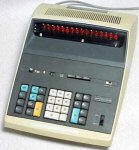
Toshiba Model from 1969
|
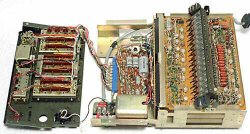
Disassembled Calculator
|
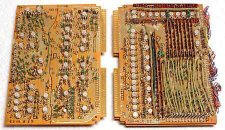
100
MSI ICs and 82 Transistors
|
|
|
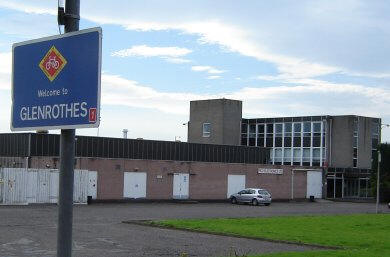
Elliott MOS Research Laboratory |
The Formation of Pico Electronics Ltd
Elliott Automation was a significant British computer
maker who in the 1960s realised the need to progress its own
semiconductor technology. In 1966 the company established a
facility in Glenrothes to manufacture
Resistor-Transistor Logic and
Diode-Transistor Logic , followed by the establishment
of a MOS research laboratory. Geoff Brookes, Alan Strath and
George Stevenson relocated from Borehamwood to Glenrothes to
establish the MOS facility (1).
One of their first tasks was to produce an 8-bit computer
using MOS technology, with George as the computer expert. In
1967 Elliott Automation merged with English Electric, and
when GEC bought English Electric in 1969 they decided to
close their production plant in Glenrothes.
Alan Strath had predicted the closure in 1967. "Since
English Electric had recently completed a new
microelectronics factory in Chelmsford, Essex, we expected
that the Glenrothes facilities would be closed, so we
successfully offered our services to
General Instrument to establish a new facility". The
Glenrothes facilities were complemented by the
Hughes Aircraft factory that had been established in
1960 to produce germanium and silicon diodes and
transistors, before moving into MOS design and production
during 1967/1968.
In the summer of
1970 four General Instrument design staff left to form Pico
Electronics Ltd. They were George Stevenson, David Campbell,
Harry McLennan and Les Leech. George was the Director of
Engineering and the others were young, bright designers. All
had previously been at Elliott Automation. Moses Shapiro,
the CEO of GI advanced some startup capital on the basis
that GI would get exclusive rights to the manufacture of
the single chip calculator ICs that the new company were
planning to develop. They set up in a rented office in the
Postgate in Glenrothes and very quickly put their design
ideas into practice. The team already had a significant
legacy in successful calculator chip design with one of the
last jobs they had completed in GI being a five chip set for
a
Facit calculator. The team had designs for calculators
going back to the Elliott days for
Bell Punch. |
|
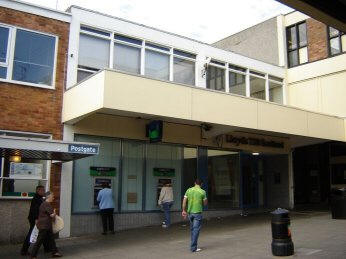
Location of Pico's First
Design Office
|
|
David Campbell remembered the
first IC development at Pico Electronics.
"We were certainly not aware that any other company in the
world was working to develop a single chip calculator at
that time. George Stevenson was the project leader and it
was he who came up with the advanced and novel architecture
used in that first calculator chip. I have always admired
that achievement and give him full credit for it. The other
guys, myself included had the job of converting his design
ideas to a working chip using a 4 mask 10 micron metal gate
PMOS technology. My own contribution was the design and
layout of the program ROM and the dynamic RAM memories and
the timer. This first machine was really advanced for its
time, because it was a Reduced Instruction Set (RISC)
processor. For example an 8 bit floating point addition of 2
numbers required just one line in the ROM. The whole program
for the calculator was only 70 lines of ROM. The ROM was
wide to allow the different parts of a calculation to be
done in parallel. This meant that although the clock speed
of the ROM was very low, the time to perform calculations
was much quicker than other calculator chips which emerged
in the years after our chip. The layout of the chip was done
by hand because there were no software design tools for
layout at that time. The layout was done by drawing the 4
layers of the PMOS transistors at 500 X scale onto a stable
mylar film with a grid pattern. The transistors were
represented by rectangular boxes for the drain, source,
gate and contact, and the metal interconnection layer was
drawn as rectangular lines. There was also no computer
simulation of the design prior to layout. To prove the
design concept we built a fully functional but not very
reliable breadboard using off the shelf TTL logic chips
soldered onto a number of stripboards which were just
connected together by wires."
David Campbell continues. "The Pico calculator chip had
stored program memory in the form of a ROM which worked in
the same way as the ROM inside a microprocessor to perform a
series of pre-programmed instructions. Remember in those
days there was no OTP which could allow a microprocessor
chip to be re-programmed. All the initial single chip
microprocessor applications had hard wired mask ROM code.
Applications which used external ROM or RAM for program
memory and scratch pad memory were not single chip
applications". Re-programming was still possible through a
change in the ROM mask.
The design was completed very quickly and fabbed at GI's
facility. David remembers the fab cycle time being a few
weeks. GI's process in those days was state of the art and
the design worked very early on. By the end of 1970 they had
working silicon and a working calculator prototype to
demonstrate to potential US and Japanese customers. Very
quickly the Monroe Calculator Company (Litton Industries) of
New Jersey became Pico and GI's first major customer of
the IC in early 1971. Pico also designed the styling and all
the electronics for Monroe's consumer models. Later in 1971
or 1972 Clive Sinclair also used Pico's chips in his
calculators
Sinclair Calculators. (Alan
Strath remembers Clive Sinclair visiting GI in Glenrothes
not knowing anything about the technology, and two weeks
later he was back, an expert !)
Intel announced their 4004 microprocessor in November 1971
Intel 4004 Website.
This had been designed into a Busicom calculator earlier in
1971 but had been an exclusive design. If you compare Pico
to Intel in those early days, the guys who formed Pico had
significant design experience on calculator chipsets for a
number of different calculator manufacturers. Their vision
in setting up their independent company was to develop
single chip processor ICs for calculators. Intel had a
couple of designers in a new lab who happened to take on a
design from Busicom. It was Busicom's idea to develop a
calculator platform on which a wide range of calculators
could be made. However in reality they couldn't develop
follow-on machines with better capabilities, and couldn't
compete with other solutions coming onto the market. It was
this failed strategy that encouraged Intel to seek
alternative markets for their device. Calculators were
becoming the largest single market for semiconductors and
attracting increasing competition. |
|
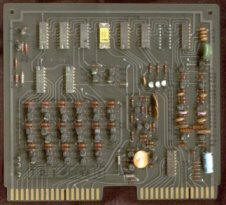
Busicom Calculator CCA With Intel Chipset
|
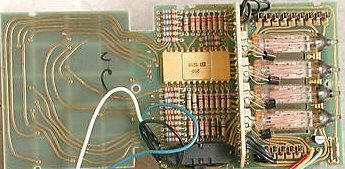
Royal Digital III With Pico/GI Chip
from 1971
|
Texas Instruments had also been designing
more integrated versions of their ICs for calculators, however they were
behind Pico. David Campbell remembered visiting TI in Houston after the
Pico chip had been in production at GI for some time.
"I remember visiting TI in Houston with George Stevenson in 1972 after
our chip had been in volume production for some time when they told us
about their one chip calculator. The chip size was huge and it was very
slow compared to ours. They called a chip a "Bar" rather than a die
which I thought was odd at that time. The visit was arranged by Monroe
in response to TI's effort to try to replace our chips in the Monroe
calculators."
If you examine Pico's patent
4,001,556 (GB version filed in March 1971, US version in July 1971)
and compare with the often cited patents of Intel (3,821,715
and 3,753,011 Intel
4004 Patent Webpage) and TI (3,819,921
3,757,306), the Pico one presents a strong case. Both the Pico and
second TI patents are the only ones to make claims on single chip
devices but Pico's pre-dates TI's and is more integrated, having the
processor on chip with ROM and RAM. Much later on, TI invested a huge
amount of effort to get Michael Cochran and Gary Boones' patent
6650317 filed which must have been in response to the claims of
Gilbert Hyatt on the invention of the microprocessor. The patent is
incredibly well researched and cites a massive amount of prior claims
and publications including George Stevenson's "Single Chip Calculator"
and "documents produced as exhibits to the deposition of George Earley
Stevenson".


Michael Cochran and TI's Single Chip Calculator
GI Manufactured and Marketed Pico's Chip Designs
George Stevenson and his team moved on to more complex chips including a
single chip scientific calculator and went on to design all of GI's
calculator chips. Pico eventually moved from the rented office in the
Postgate to the vacated Elliot Automation MOS Laboratory building on the
Eastfield Industrial Estate. Pico Electronics Ltd is still in existence
as part of X10 Ltd.
David Campbell and Pico continued to produce a number of innovations
including the de-facto X10 standard for Home Automation. George
Stevenson and Les Leech are still at X10 in Hong Kong. Further Pico and
X10 history can be found at
Pico and X10 History. Pico Electronics still own the Elliott
building, however most business is now operated out of Hong Kong. Until
his recent retirement, Harry McLennan still worked at Pico in Eastfield.
Another early Pico employee, Dave Thompson who worked with David
Campbell on the first X10 automation chips is still at Eastfield. David
Campbell has been an independent IC design consultant for a number of
years.
General Instrument in Glenrothes continued to produce a number of Pico's
calculator IC designs and other consumer chips including the X10 ICs. GI
eventually moved their US Hicksville NY facility to Arizona, from which
they spun out the PIC microcontroller business into Arizona Microchip in
1989. The GI wafer fab in Glenrothes still operates as an independent
wafer foundry.
(1) Alan
Strath remembers, "I joined Elliott Automation in 1965. We started up in
Scotland in 1966 and I think the EE takeover was in 1967.
We started with GI in the same year, with
temporary accommodation in two adjacent Glenrothes Development
Corporation terraced houses in South Parks road. George and some of
his recruits worked on designs on the ground floor while we pursued
the conversion of a standard advance factory as a semi plant and
ordered equipment. The Daily Express printed that the MD shared a
bedroom in the house with his secretary ! I believe that GEC took
over EE in 1968 or 1969, although I'm not sure. As you may know,
Elliott Auto had taken a licence with Fairchild, initially for DTL.
During this period we met Robert Noyce, CEO of Fairchild and Gordon
Moore, R& D manager. They left Fairchild saying that it had
mushroomed out of control.
The production unit at Queensway closed in 1968
or 69 and partially moved to the R&D factory at Eastfield (now
Pico)."
An interesting if trivial footnote is that the Elliott Automation
production facility was established in part of the Cadco "pig
factory" in Queensway Industrial Estate. Cadco was an investment by
the actor
George Sanders. Sanders was well known for playing the "cad" in
films, and in a remarkably ill-conceived business venture in the
early '60s, having always harboured dreams of becoming a tycoon,
threw his name and most of his money into a sausage-making scheme
that went belly-up, taking his company, Cadco Ltd., with it. He was
ruined financially and barely escaped prosecution.
|








